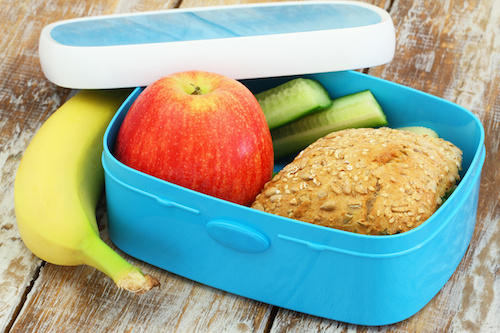Childhood obesity has become a widespread problem due to fewer opportunities for exercise and more time spent watching TV, playing video games, texting and surfing the Internet. The Centers for Disease Control and Prevention reports that obesity in America has more than doubled in children and quadrupled in teenagers over the last three decades.
Obesity is more than just an appearance issue. Obese children and teenagers are more likely to develop serious health problems, including diabetes and high blood pressure. Although it may be more challenging to stay fit these days, there are a few things you can do to help your kids remain healthy. These six tips for obesity prevention in children will help ensure your children don’t suffer from the social and physical challenges of obesity.
Focus on Healthy Foods and Snacks
A diet that includes plenty of fruits, vegetables, whole grains, lean meats and healthy fats will help your child avoid gaining too much weight. Although an occasional fast-food meal won’t doom your child to a lifetime of obesity, it’s best to limit fast and processed foods and sugary, salty, carbohydrate-heavy snacks. Replace cookies and potato chips with healthier snacks such as:
- Carrots with hummus dip
- Celery sticks filled with peanut butter
- Whole-grain pretzels
- Red peppers
- String cheese
- Apple slices, blueberries or strawberries
- Baked corn chips and salsa

- Banana dipped in fat-free, plain yogurt
- Hard-boiled egg
- English muffin with peanut butter
- Whole-grain cereal, with or without milk
Modify Family Favorites
Obesity prevention in children can be as easy as making a few modifications to the foods your family enjoys. Try a few of these substitutions:
- Use whole-grain pasta and brown rice in recipes instead of regular pasta and white rice.
- Reduce or eliminate salt. Don’t automatically add it to foods without tasting first.
- Decrease sugar in baked-good recipes by one-half and replace it with mashed bananas or unsweetened applesauce.
- Braise, broil, grill, bake, sauté and steam foods instead of frying them. Use spray oils to limit the amount of fat.
- Add more vegetables than meat to casseroles.
- Use reduced-fat salad dressings and apply dressings sparingly.
- Substitute turkey bacon for pork bacon.
Practice Portion Control
Over the years, portion sizes have become greatly inflated. Unfortunately, even healthy foods can cause weight gain if you eat too much of them. Following recommended portion sizes can help your son or daughter avoid childhood obesity. For example, a single serving of meat or poultry is about the size of a deck of cards, while one serving of a baked potato is no larger than a computer mouse. Dietitians recommend filling one-half of your plate with healthy vegetables and the rest with whole grains and lean proteins.
Pay Attention to Hunger and Satiety Cues
Recent research has indicated that bottle-fed babies, specifically those given formula rather than breast milk, may be at increased risk of overfeeding. UNC School of Medicine researchers set out to determine modifiable factors that may reduce incidence of obesity later in life with a focus on bottle size. Through their study they discovered that babies under 6 months of age who were regularly fed formula from bottles larger than 6 ounces had greater weight gain and greater weight-for-length size than other babies the same age.
Pediatricians and researchers hypothesize that these study outcomes are likely due to parental disregard of actual hunger and satiety cues from the baby and an increased focus on the amount of formula remaining in bottles provided. A good rule of thumb is for parents and caregivers to monitor infants for signs of hunger and fullness and use these signs as a guide for the start and conclusion of feedings, no matter how little or how much formula remains in the bottle:
- Signs of hunger: lip smacking, hands in mouth, open mouth
- Signs of fullness: shaking head, falling asleep, turning or pulling away from a bottle
Choose Family Activities Wisely
Both children and parents can benefit from activities that incorporate exercise, such as walking, bike riding, swimming, tossing a Frisbee, rollerblading, playing a sport together, or participating in scavenger hunts or geocaching expeditions. These are great alternatives to watching TV or playing video games. The American Academy of Pediatrics recommends limiting screen time to no more than 1 hour per day of high-quality programming for children ages 2 to 5. Reasonable time limits should be given to children ages 6 and older depending on the quality and types of media used; no more than 2 hours per day is a good place to start.
Encourage Your Child to Pick an Active Hobby
Team sports offer an excellent way for children to stay in shape and have fun at the same time, but some children don’t enjoy organized sports. If your son or daughter has no desire to join the team, look for other activities to provide a regular source of exercise, such as gardening, horseback riding, skate boarding, dance or martial arts lessons, surfing, bowling, ice skating or golf. Keep in mind that active children are more likely to become active adults.
Are you concerned about obesity prevention in children? The Lifestyle Medical Clinic dietitians can help you create a healthy-eating plan your entire family will enjoy. Contact us today to schedule an appointment.

Sources:
Women’s Day: The Major Public Health Crisis Facing American Girls
Diabetes Care: Exercise and Type 2 Diabetes
AAP Screen Time Recommendations

